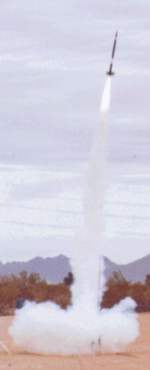Scratch Max-Q-Tip Original Design / Scratch Built
Scratch - Max-Q-Tip {Scratch}
Contributed by Moira Jean Whitlock
| Manufacturer: | Scratch |
 Brief:
Brief:
This is a daring single stage rocket designed to go supersonic and yet hold together. It also will go quite high, so do check your waiver!
Construction:
It's quite easy to build. The fin set is a 38mm Acme fin canister obtained through Northern Hobbies on ROL auctions. The body tube is a standard 36 inch length of 38mm flexible phenolic tubing. The fin canister is epoxied onto one end of this tube with a generous amount of 12 minute epoxy.
The launch lug in the mark 1 version was a 6-inch length of 13mm body tubing gotten from Rogue Aerospace. It was epoxied with the same glue starting at six inches above the top of the fin canister. The nose cone is a PML solid urethane conical model. It gives the rocket a long lean mean look. This nose cone comes with a screweye embedded into its base, so there is an easy attachment for the 10 feet of 1000 lb. Kevlar® cording and 20 inch parachute. The cording came from Recovery Technologies. They can be found on ROL. The parachute is made of rip stop nylon and I made it myself. The shock cord is anchored aftward via a small screweye that goes through the forwardmost centering ring on the motor mount, which is 12 inches of 29mm flexible phenolic tubing. This tubing and the three centering rings used came from Space Modeling Solutions. They can be found on ROL.
Decoration was via fuelproof green polyurethane spray paint and self-adhesive lens paper. The latter came from American Science and Surplus, and they have a site on ROL. The resulting rocket is strong, simple, sleek, and sharp looking, literally.
 Flight:
Flight:
I use Rocksim 3.0 and 4.0 from Apogee Components to choose motors and delays. The program predicts apogee ejection with the long delays for the 29mm motors. First flight was with a G40-10W. It went nearly out of sight. Recovery was perfect, but I had a bit of a walk. Then I don't know what possessed me this past Saturday, buy I flew it with a new Aerotech I 200-W long delay. The rocket seemed to pause for the merest second after I pressed the almighty button, then a little fire appeared, then the rocket screamed upward on a flame trail that seemed to be ongoing even as the rocket reached the clouds. Mind you, the clouds were said to be 6500 feet up. The rocket pierced these clouds. Only an onlooker with binoculars could help me sight in on my bird up there with a bright red parachute, which landed a mile downrange. I had to shimmy under two barbed wire fences and got stickers in my hair to get my prize back!! As it went up, I heard someone say the Lord's name, then the announcer said that the waiver was broken. Do bear this in mind if you try this yourself.
It was a dandy flight, but I'm never proud to break any rules. My husband said that at Max Q, the shape of the smoke trail suddenly changed. Maybe it reached mach.
The motor was retained with two loops of piano wire that were epoxied through the aftmost centering ring. These loops bend over the thrust ring but do not extend over the nozzle. A redundant mechanism of retention is an automotive hose clamp that closes over the wires and the thrust ring.
 Summary:
Summary:
A real performer and easy to build. Possibly a certification rocket for a cooler motor like an H128. But be prepared to walk. The mark 2 version uses two lower drag Acme conformal launch lugs, gotten via ROL auction from Northern Hobbies Online. Rocksim does not yet acknowledge the fin canisters as parts on the database, so my simulation was at best an approximation. I don't think the rocket was too expensive for its performance. The fins and lugs ran me about $24, the body tube $5, the nose cone $12, and the centering rings $2.
Other:
Obey your waivers. And see if there are any single use motors for this one. I nearly lost my 29/360 hardware. My husband nearly called my search off, but I was too stubbornly determined to get this back.
Sponsored Ads
 |
 |











